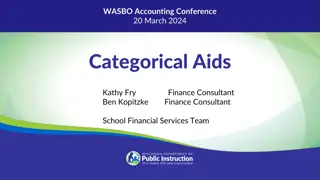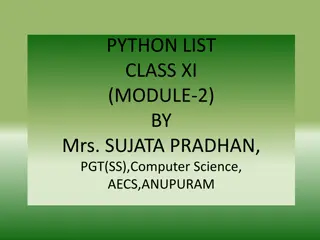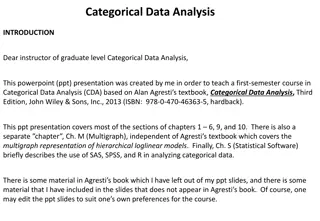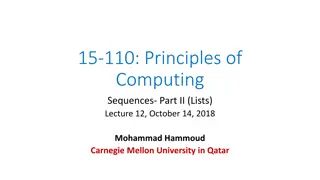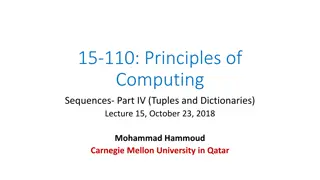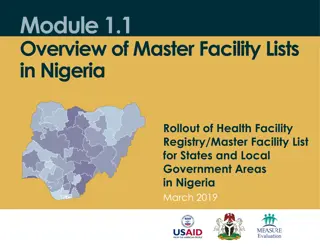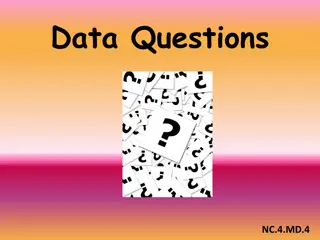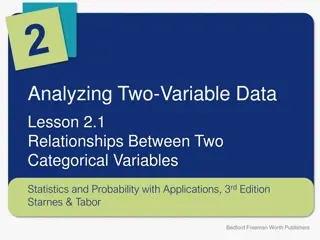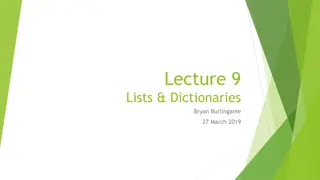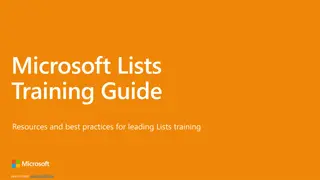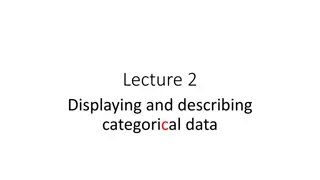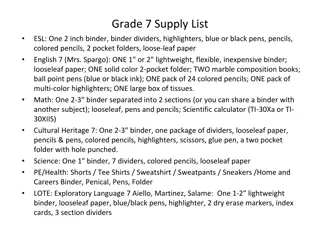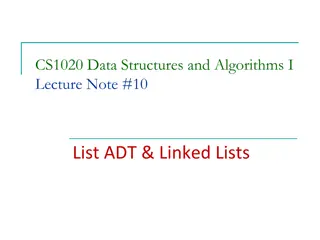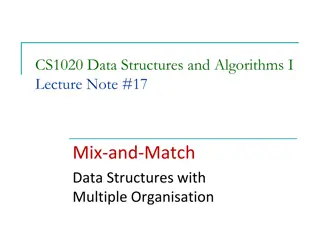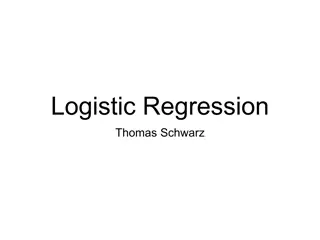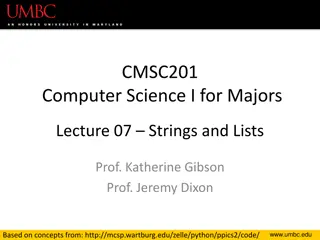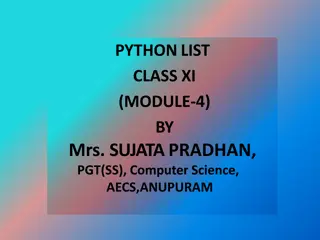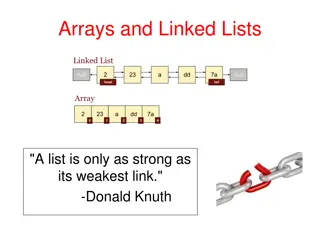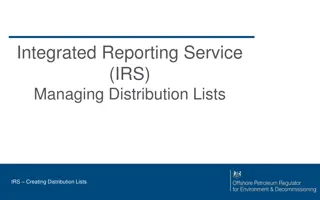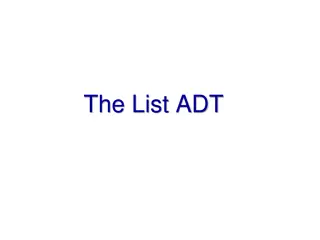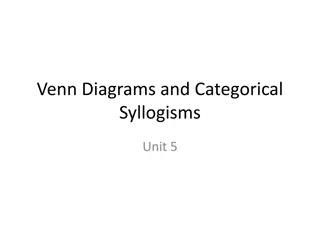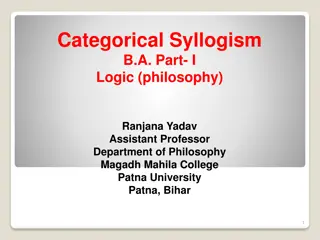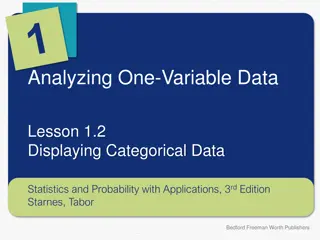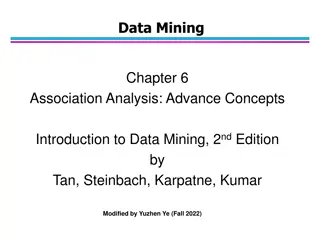Tips and Tricks for Using Create Lists in Sierra
Discover valuable insights on tips, best practices, and shortcuts for optimizing your use of Create Lists in Sierra, presented by Stacey Wolf from the University of North Texas at #IUG2021. Learn about tools, functions, and innovative uses of Create Lists beyond Sierra's functionalities. Explore rec
6 views • 134 slides
Overview of Categorical Aid in Education Finance
Categorical aid in education funding serves specific purposes such as special education, transportation, and mental health. It operates outside revenue limits and often comes in fixed or prorated amounts. The process involves targeted grants and reimbursement formulas. Special Education & School-Age
1 views • 36 slides
Understanding Threads, Linked Lists, and Programming Models in Concurrent Programs
Delve into the concepts of threads, linked lists, and programming models in concurrent programs. Explore the use of threads for handling multiple requests, the struct types in programming, and the various access methods for lists. Learn about the benefits of threads and how they enable parallel proc
0 views • 44 slides
Python List Operations and Usage in Programming
Lists in Python are versatile data structures that allow storing an ordered sequence of items. This article covers the basics of lists, key operations such as indexing, slicing, concatenation, repetition, membership checks, and traversing lists using loops. Understanding these fundamental concepts i
1 views • 14 slides
Graduate Level Categorical Data Analysis Course
This PowerPoint presentation offers a comprehensive guide to teaching a first-semester course in Categorical Data Analysis at the graduate level. Covering key sections from Alan Agresti's textbook, the presentation includes real-data examples, software guidance, and solutions to exercises. The instr
1 views • 5 slides
Introduction to Creating Lists in Python
In this lecture, the focus is on lists in Python, which are more general than strings as they can contain arbitrary objects. The session covers creating lists with numbers, strings, or mixed elements using square brackets, list comprehension, and built-in list type objects. Additionally, topics such
1 views • 34 slides
Understanding Tuples and Dictionaries in Computing Sequences
Tuples are immutable data structures similar to lists, written with round brackets. They can contain different types of elements, be sliced and indexed similarly to lists, concatenated, repeated, nested, and passed by value to functions. Examples show how tuples operate and differentiate from lists.
1 views • 21 slides
Overview of Master Facility Lists in Nigeria: Rollout of Health Facility Registry
The document provides an overview of the master facility lists (MFLs) in Nigeria, focusing on the rollout of the Health Facility Registry (HFR) for states and local government areas. It discusses the elements of functional MFLs, the process of facility listing, HFR development, governance plans for
1 views • 16 slides
Understanding Categorical and Numerical Data in Mathematics
Explore the distinction between categorical and numerical data in math. Learn how mathematicians categorize and analyze data, sorting cards into different categories to understand similarities and differences. Develop perseverance skills by determining survey question types and defining data types w
0 views • 9 slides
Analyzing Relationships Between Categorical Variables in Statistics
Explore relationships between two categorical variables in statistics, distinguishing between explanatory and response variables. Learn to create segmented bar charts and identify associations. Understand the importance of identifying explanatory variables in analyzing data relationships. Improve yo
0 views • 15 slides
Introduction to Lists and Dictionaries in Python
This lecture discusses Lists and Dictionaries in Python programming. It covers the differences between these two data structures, their usage, variable storage, and handling larger data sets. The session introduces Lists as containers for related data pieces and explains how to create, access, and m
1 views • 36 slides
Comprehensive Microsoft Lists Training Guide
Explore resources, best practices, and training methods for leading Microsoft Lists training sessions. Understand the training approach, key audiences, scenarios, and preferred learning methods. Get insights on engaging managers, admins, change champions, knowledge workers, and mobile workers. Enhan
0 views • 13 slides
Parallel Chi-square Test for Feature Selection in Categorical Data
The chi-square test is a popular method for feature selection in categorical data with classification labels. By calculating chi-square values in parallel for all features simultaneously, this approach provides a more efficient solution compared to serial computation. The process involves creating c
1 views • 4 slides
Year 4 Spelling Lists and Patterns for Weekly Lessons
Attached are the spelling lists for Year 4 covering various patterns, homophones, prefixes, and suffixes. Students are expected to learn these spellings weekly for dictation tests on Fridays. Additional words are included to reinforce the spelling rules. The lists also focus on adding suffixes, pref
0 views • 5 slides
Visualizing Categorical Data in Data Analysis
Explore methods for displaying and describing categorical data effectively, from frequency tables to bar and pie charts. Understand the importance of visual representation in drawing insights and making comparisons. Dive into examples using football team data and Titanic survivors. Learn to identify
1 views • 20 slides
School Supply Lists for Grades 7, 8, and 9
Various grade-specific school supply lists for Grades 7, 8, and 9 including items like binders, dividers, pens, pencils, folders, loose-leaf paper, calculators, highlighters, colored pencils, and more. Each grade level has its unique requirements listed for subjects like English, Math, Science, Cult
0 views • 7 slides
Abstract Domains for Lists and Heap Structures: A Comprehensive Overview
Explore the concepts of quantified data automata on skinny trees, automatic shapes in static analysis, universally quantified properties on lists, heap configurations with skinny trees, and the extension of quantified data automata over lists. Dive into the abstract domain of automata to capture inf
1 views • 20 slides
Introduction to Resource Lists at University of Edinburgh
Explore the benefits and functionalities of Resource Lists at University of Edinburgh, a service utilizing Talis Aspire to create and manage reading lists. Learn how to create lists, add bookmarks, and access core reading materials easily. Discover the system's flexibility, collaborative features, a
0 views • 19 slides
Analyzing Categorical Growth and Values Table in Accountability Panel
Analyze the growth and values table in the accountability panel through categorical growth and status improvement tables. The subgroups' significance of categorical status changes is assessed using a rating system. Temporary cut scores for sub-categories have been employed for evaluation, with a foc
0 views • 51 slides
Understanding List Operations in Python
A comprehensive guide to list operations in Python, covering topics such as defining lists, performing functions on lists, indexing, slicing, and more. Learn about the basics of lists, initializing lists, updating elements within a list, deleting list elements, and common list operations like concat
0 views • 26 slides
Understanding List ADT and Linked Lists
This content emphasizes on the List ADT and Linked Lists in the context of data structures and algorithms. It covers the definition of List ADT, implementations using arrays and linked lists, Java API LinkedList class usage, and various types of linked lists such as BasicLinkedList, EnhancedLinkedLi
0 views • 82 slides
Understanding Chi-Square Tests in Statistics
Chi-square tests in statistics are used to examine the relationship between categorical variables or test claims about categorical variable distributions in populations. The Chi-square test statistic measures the discrepancy between observed and expected counts, with the Chi-square distribution help
0 views • 16 slides
Mix and Match Data Structures for Efficient Algorithms
Discover how to combine basic data structures like arrays, linked lists, and trees to create specialized data structures for various applications. Explore the concept of mix-and-match data structures with multiple organizations to implement efficient algorithms like adjacency lists and matrices for
0 views • 12 slides
PuReMD Design - Initialization, Interactions, and Experimental Results
PuReMD Design involves the initialization of neighbor lists, bond lists, hydrogen bond lists, and coefficients of QEq matrix for bonded interactions. It also implements non-bonded interactions such as charge equilibration, Coulomb's forces, and Van der Waals forces. The process includes the generati
0 views • 23 slides
Understanding Binary Outcome Prediction Models in Data Science
Categorical data outcomes often involve binary decisions, such as re-election of a president or customer satisfaction. Prediction models like logistic regression and Bayes classifier are used to make accurate predictions based on categorical and numerical features. Regression models, both discrimina
0 views • 67 slides
Understanding Categorical Data Analysis for Proportion Estimation
In the realm of categorical data analysis, estimating proportions is crucial for understanding population characteristics. This involves sampling, calculating sample proportions, standard errors, and constructing confidence intervals. Through examples like studying the effects of treatments on medic
0 views • 72 slides
Categorical Data Analysis in Population Studies
Inference methods for estimating proportions in a population are essential in categorical data analysis. This includes techniques for single proportions, confidence intervals, sample size determination, and Wilson-Agresti-Coull method for small sample sizes. Illustrated with examples and visuals, th
0 views • 80 slides
Understanding Lists and Strings in Computer Science I
In this lecture, we delve into the concepts of lists and strings in computer science, exploring their importance, representation, and built-in functionality. We discuss the utility of lists to store and manage data efficiently, compared to using individual variables for each data point. By understan
0 views • 44 slides
Exploring Python Lists in Class XI Module-4 by Mrs. Sujata Pradhan
Exploring list structures, characteristics, and operations in Python. Covering topics such as mutability, basic list operations, indexing, slicing, concatenation, repetition, traversal, updation, and comparison. Detailed explanations on list methods like append, extend, insert, index, sort, count, r
0 views • 12 slides
Inserting a Number into a Sorted List Using Linked Lists
Implementing the task of inserting a new number into a sorted list of numbers efficiently using linked lists. The solution involves creating a linked structure where nodes are linked together in linear order, allowing for constant time operations. By utilizing linked lists, the insertion process can
0 views • 15 slides
Understanding Arrays and Linked Lists in Computer Science
Arrays and linked lists are fundamental data structures in computer science. Arrays provide a fixed-size collection, while linked lists offer dynamic sizing. Arrays are efficient for accessing elements but can be inefficient for insertions and deletions. Linked lists, on the other hand, allow for ea
0 views • 42 slides
Streamlining EMS Documentation: Defined Lists for Efficient Patient Care
EMS clinicians face challenges in documentation due to extensive lists of values. The transition from suggested to defined lists, initiated in 2016 and refined in 2019, aims to improve documentation accuracy by presenting commonly used values to providers during patient care instances. This process,
0 views • 12 slides
Understanding Categorical Data Displays and Analysis
Visual displays of categorical data such as bar graphs, pie charts, and frequency distributions help organize and interpret large amounts of data effectively. Different types of graphs serve specific purposes, like comparing categories visually and identifying modes easily. This overview covers the
0 views • 10 slides
Managing Distribution Lists in Integrated Reporting Service (IRS)
Integrated Reporting Service (IRS) allows users with Notification Submitter privileges to create distribution lists to inform interested parties about notifications submitted. Creating distribution lists saves time by eliminating the need to repeatedly enter email addresses, ensuring all relevant pa
0 views • 5 slides
Understanding Abstract Data Types: Lists Exploration
Explore the concept of list abstract data types, different classes of lists, and various list implementations including ordered, unordered, and indexed lists. Understand how elements are organized in ordered lists based on characteristics, how unordered lists allow flexibility in element placement,
0 views • 41 slides
Understanding Venn Diagrams and Categorical Syllogisms
Venn diagrams, introduced by John Venn, visually represent relationships between different classes. Shading in diagrams signifies empty sets or no overlap between classes. Different types of categorical statements such as universal and particular are illustrated using examples. Explore how Venn diag
0 views • 30 slides
Understanding Categorical Syllogism in Logic: A Comprehensive Overview
Categorical syllogism, a form of inference with two premises and a conclusion, is a fundamental concept in logic. This type of deductive argument consists of three categorical propositions - universal affirmative, universal negative, particular affirmative, and particular negative. Terms such as maj
0 views • 16 slides
Displaying Categorical Data: Bar and Pie Charts
This lesson explores the visual representation of categorical data using bar and pie charts. Learn how to create and interpret these graphs to display variable distributions clearly. Understand deceptive graph practices and master the skills to make accurate and informative data displays in Statisti
0 views • 16 slides
Advanced Concepts in Association Analysis: Handling Categorical Attributes
Explore advanced concepts in association analysis, focusing on the handling of categorical attributes. Learn how to apply association analysis to non-asymmetric binary variables, including examples and potential solutions for skewed attribute value distributions. Discover techniques for managing att
0 views • 48 slides
Introduction to List Comprehensions in Computer Science
Learn how to utilize list comprehensions in Computer Science to efficiently create new lists based on existing data. This article covers examples and explanations of list comprehensions, including building lists from other lists, applying calculations per element, and filtering elements to create sp
0 views • 21 slides

